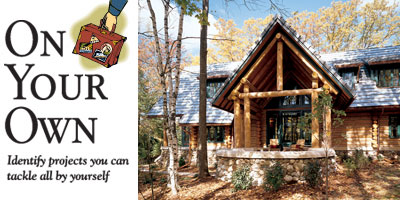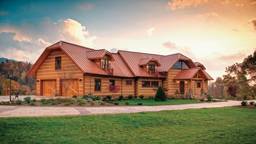
Rich Moen dreamed of a log home since he was a child. As an adult, he built his dream home in Goshen, New Hampshire, from scratch. "The scariest part is just waiting for the logs to be delivered," he says. "After that, it all just seems to fall into place." It didn't hurt that Rich had the dedicated help of his parents in building the 2,300-square-foot home. Together, they stacked logs, pre-cut by log producer Country Log Homes, on a foundation they built. They installed floor joists, plumbing and electricity, hiring a professional crew to build the roof system and install the windows and doors. Like many home owners, Rich was looking for ways to cut costs on his home by investing his own time and energy. He saved thousands of dollars and grew closer to his parents in the process. If you're thinking about doing some projects yourself, either to save money or to put your own imprint on the house, keep your abilities and time constraints in mind. A few projects you might consider are log finishing, chinking, tiling and painting.
Exterior Log Finish
By choosing to finish your own logs, you'll get to know every inch of your new log home. With any type of finishing project, the experts recommend following the product application instructions to the letter for the best possible results.< Kim Hupila, a customer service representative at Schroeder Log Home Supply, suggests starting your exterior work with a borate treatment for the logs. Borate, which serves as an insecticide, may have been applied by your log producer, or it may be an ingredient in the log finish product you select. The next step is to take a few readings. "Make sure the wood temperature is at least 50 degrees," Kim says. Remember, the air temperature may be above 50 degrees, but the logs could be cooler. Hold off on finishing your logs until they've dried to a moisture content of 18 percent or lower. Kim recommends using a moisture meter, which may be rented or borrowed from your finish supplier or log producer, to test the moisture content of your logs. Keep a close eye on the Weather Channel, too. "You want a minimum of two days without rain," Kim says, "because rain will destroy the finish." Most tools for this job are readily available. You can brush on the finish or use a sprayer (either rented or purchased). Kim advises that most products require back-brushing if they're sprayed on. Finishing your log home is a good job for do-it-yourselfers. "It's not a real exact science," says Dean Johnson, host of "Hometime," the PBS series. "It just depends on your willingness to get up on a ladder." You don't need years of experience to do the job well, but you will need to follow the directions and consult with the product manufacturer to answer any questions. Remember, if you ignore the application instructions, your finish could fail quickly and need to be replaced or maybe even removed by a professional.Chinking
Hundreds of years ago, log home owners daubed mud, straw, animal hair or plaster between logs to seal their homes. Today, synthetic compounds do the job, but chinking an entire house is still a major undertaking. Because this job requires a degree of skill, you may want to leave it to a professional. If you plan to give chinking a try, take time to perfect your technique. "Practice is a good thing," Kim says. "You want to be sure the tool you're using isn't too wet or not wet enough." She suggests running a bead of chink onto scrap wood and then trying to tool it smooth. You can make the job easier by tackling it in warmer weather. Chinking tends to stiffen when the weather or the product itself is cold. Be sure the chinking product you choose is compatible with your wood finish, regardless of whether the finish will be applied before the chinking is in place or after. If you think you could use some guidance in chinking your home, try locating an experienced chinker who will let you work alongside him to learn the ropes.Interior Log Finish
One key to success for the do-it-yourselfer who wants to finish the interior of a log home is timing. "Apply finish before the windows go in," Kim says. If you wait until the windows are in place, you'll need to tape them off carefully to avoid any runoff or overspray. The same is true for floors. It's better to apply the product before the finished flooring is installed. Again, you'll need to be sure the wood temperature is at least 50 degrees and that you've read and understand the application instructions. Kim says that applying too much finish too soon is a common mistake amateurs make. Be sure to wait the recommended time between coats. She also warns against mixing your own colors. "It's too hard to match them again if you need to," she says.Tile
Installing tile can be an excellent do-it-yourself project, if you take your time, says Christie Lousch of InStyle Tile & More in Billings, Montana. "Patience is always something I tell do-it-yourselfers," she says. "Try not to put a deadline on the project, because it is time-consuming." If you're considering a tile job, but have little or no experience, start by tackling a floor tile project first. "Floors are easier to keep straight, and you can hide things, like bad cuts, under the baseboards," Christie says. "Wall tiles tend to have smaller grout joints, making them harder to keep straight." Countertops are also more difficult, Christie advises, because they typically involve trim pieces. Preparation is the key to a good tile job. Make sure that whatever material the tile will sit on is perfectly flat. "A tile job is only as good as what you have under it," Christie says. You also should plan out the tile placement well to make sure you have the fewest cut tiles as possible. Cleanup is important, too. Grout and grout haze must be thoroughly removed from the finished tiles before the grout becomes too hard. Tiling requires just a few basic tools: a trowel, grout float, sponges, bucket and something to stir with. You may want to purchase a tile cutter, Christie says, but unless you have a very large job, you don't need to buy a wet saw. Many home improvement centers or tile retailers will have a wet saw available for rent.Painting
Interior painting seems like a project just made for do-it-yourselfers. Still, there are common mistakes you should take care to avoid. The experts at Sherwin-Williams advise that if you're painting new walls, you should be sure that all drywall compound is thoroughly dry before painting. New walls should be sanded smooth and any dust should then be removed before paint is applied. The experts at "Hometime" sing the praises of primer. "Without priming," they say, "new wood, plaster or drywall surfaces will soak up more finish paint in some areas than others, producing a splotchy effect." Use primer as your first coat, and you probably won't need as much of the finish paint-a bonus since primer is less expensive than paint.>Got a Tool Belt?
Log home owners tend to enjoy the projects they take on. "Part of the fun of a log cabin is just putzing around," Dean Johnson says, "doing things that don't have to be done, but that just make it nicer. They become fun family projects." Steve Carpenter, who with his wife Deborah built much of their 4,000-square-foot log home, agrees. "One of the most fun things we've got going here is all the video and pictures we've taken of our construction," Steve says. "It gives you a nice record of your project." And while your home projects may take longer than you'd like and cause some frustration along the way, when they're finished, they bring a lasting sense of accomplishment. Home owner Rich Moen, who spent 10 years building his home, sums it up: "It's not just a house," he says. "It's a labor of love."
Quick Tips for Do-It-Yourselfers
|











